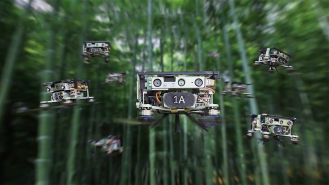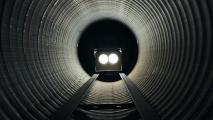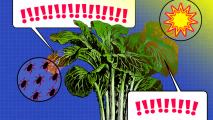Watch a drone swarm navigate a bamboo forest
Researchers at Zhejiang University and Hong Kong University of Science and Technology (HKUST) have developed a new system that allows swarms of drones to operate in crowded airspace.
In a scene straight out of sci-fi — and a first for an autonomous drone swarm — 10 of their robots knife through bamboo thickets, finding optimal flight paths and avoiding running into each other.
While the mind may jump — or mine does, at least — to a relentless horde zooming after our hero, a drone swarm capable of independently navigating complex, obstacle-filled environments could serve multiple beneficial purposes, the researchers write in their paper, published in Science Robotics.
They could search for survivors or deliver supplies in the aftermath of an earthquake or flood; scout the scorching front line of a wildfire; explore ecosystems with minimal human footprint; or, more fantastically, form the basis of air traffic control systems on Mars.
“Being the first swarm system capable of decentralized, autonomous flight in an unstructured environment, this work presents notable contribution to the robotics community,” Enrica Soria, a doctoral assistant at Switzerland’s École Polytechnique Fédérale de Lausanne, unaffiliated with the study, writes in a companion article.
The drone swarm knifes through bamboo thickets, finding optimal flight paths and avoiding running into each other.
Finding a way: Real-world uses of an aerial drone swarm already exist, of course; think Lady Gaga’s Super Bowl light show.
But those drones are operating on preprogrammed flight paths — they can only go where they’ve been told to go — “blind and passive,” as Soria puts it.
Such a drone swarm can’t adjust to flying through new places cluttered with uncharted obstacles, like a city street or thick jungle.
“In these scenarios, previously unknown surroundings and narrow corridors combined with requirements of swarm coordination can create challenges,” the study authors write.
The team took inspiration from birds’ ability to flexibly coordinate their flock’s flight path. When our feathered friends are maneuvering through a forest, each one can rely on their senses of sight and balance to adjust, ahem, on the fly.
(Video courtesy of Zhejiang University)
Their drone swarm took a similar approach, with each tiny, fully autonomous member armed with its own sensors, including a camera for identifying obstacles and neighbors and an ultra wideband sensor to correct for position in midair. All of the sensors are fed into an algorithm in an onboard computer that can form the drone’s flight path within milliseconds.
The drone swarm was then put to the test in a wild bamboo forest, where they avoided obstacles, people, and each other.
The future of drone swarms: Further work will need to optimize a drone swarm capable of navigating dynamic environments on its own. Understanding how the drones can prioritize their behaviors, Soria writes, could help them achieve various tasks more effectively, as well as figuring out how to balance human input with high autonomy.
And while the team’s drones were all the same kind, future swarms may feature different drones with different abilities.
“Research in these directions will give additional momentum to the commercialization and usage of aerial swarms for real-world applications at an unprecedented pace,” Soria writes.
We’d love to hear from you! If you have a comment about this article or if you have a tip for a future Freethink story, please email us at [email protected].





